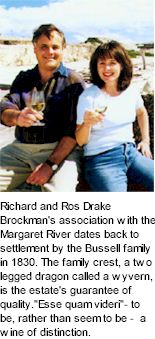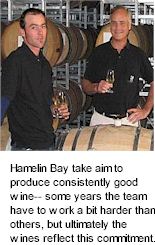


Richard's great-grandmother Grace Bussell is famous for her courage as a 16 year old when in 1876, with the assistance of aboriginal stockman Sam Isaacs, she rescued the survivors of the shipwreck Georgette at Redgate Beach not far from the mouth of the Margaret River. Richard's great-grandfather Frederick, known for his exploration of the Kimberley, read about the heroic feat in Perth's press and rode 300 km on horseback to meet her. They married in 1882.

Hamelin's Bay Vineyard and winery operation is located within a few kilometres of Karridale, at the intersection of the Brockman and Bussell Highways which were named in honour of both these pioneering families. Hamelin Bay was the first commercial winery to establish in Karridale but there has been significant development in recent years as winemakers seek out the more elegant flavours associated with the longer ripening period available in the area. Karridale fruit is always the last to ripen generally between mid March and mid April for the major varieties.
In summer Hamelin Bay is a popular beach for swimming. It has remnants of the original 19th century jetty used for shipping lumber to Britain which was largely destroyed by fire in recent times. The stingrays swim up to feed on fish waste from fishermen and are known to nibble one's toes, while wading, when the fishermen are not about. They are not considered dangerous, except for their tails of course. The bay's mostly untouched sandy beach stretches for miles to the north of the public access alongside the Leeuwin Naturaliste National Park.
Hamelin Bay's cellar door is a contempory mix of steel and glass with a magnificent granite entry. Designed by architects Grounds Kent of Fremantle, the cellar door is set high with sweeping views over the Five Ashes vineyard, the Rushy Creek valley below and opposing hills of lush grazing land and tall timber. It's the ideal setting for a relaxed lunch with wines served by the glass and bottle.

Hamelin Bay's vines are grown to one of Margaret River's most beautiful valleys looking north over the vineyard and 2.5 ha lake then rolling green hills of pasture and remnant forest of the giant Karri and Marri trees. The climate is equable due to the proximity of the Southern Ocean 15 km south at Flinders Bay and the Indian Ocean 8 km west at Hamelin Bay. On calm autumn days the breakers at Hamelin Bay whisper their message to the grapes to ripen quickly before the winter storms arrive. The role of the winemaker is to capture the essence of the natural environment, as encapsulated within the fruit from the vineyard.
The estate's Five Ashes Vineyard has been given its own identity named in honour of Roslyn's ancestor and Swan Valley pioneer Dr Samuel Waterman Viveash. It comprises 25.4 hectares (63 acres) of vines over 4 stages planted from 1992 including Shiraz (3.9 ha), Cabernet Sauvignon (4.4 ha), Merlot (2.3 ha), Sauvignon Blanc (6.3 ha), Semillon (4.3 ha), and Chardonnay (4.2 ha) The soils are well drained brown sandy loam gravels and the vineyard is fully drip irrigated on a north - south pine trellis with 3 metre by 1.8 metre spacings. The vines are positioned to either Vertical or Scott Henry canopies to maximise sunlight penetration. The biggest threat to production is birds and substantial areas are netted each year.
Dr John Gladstone was the person to first identify Margaret River as having great viticultural potential, a climate and winegrowing so very similar to Bordeaux. The Drake-Brockman's family crest, a two legged dragon called a wyvern, is the estate's guarantee of quality. The wyvern rampant or wild wyvern marks a separate identity, the estate's Rampant Red and White brand uses a stylised rampant wyvern on the label. The Latin ("esse quam videri") on the label is Hamelin Bay's motto "to be rather than seem to be" a wine of distinction.
